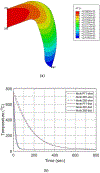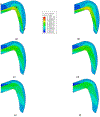Viscoelastic finite element evaluation of transient and residual stresses in dental crowns: Design parametric study
- PMID: 31760273
- PMCID: PMC7042054
- DOI: 10.1016/j.jmbbm.2019.103545
Viscoelastic finite element evaluation of transient and residual stresses in dental crowns: Design parametric study
Abstract
Porcelain-veneered zirconia (PVZ) are one of the popular choice for crown restorations. Veneer layer of these dental restorations, however, is susceptible to chipping and delamination due to the development of transient and residual stresses during the cooling phase of veneer firing. The aim of this study is to elucidate the effect of material property mismatch, veneer to core thickness ratio, and cooling rate on these transient and residual stresses of PVZ restorations. Three-dimensional viscoelastic finite element modelling (VFEM) was performed. The VFEM model was developed using the UEXPAN subroutine in ABAQUS software and was validated for transient and residual stresses in a sandwich seal problem with experimental data available. A good agreement between the simulated VFEM results and experimental data was obtained. Using validated VFEM, two PVZ systems (PM9/zirconia and ZirPress/zirconia), three veneer to core thickness ratios (2:1, 1:1 and 1:2), and two cooling rates controlled slow cooling at 1.74E-5 W/mm2°C (i.e. ~30 °C/min) and fast bench cooling at 1.74E-4 W/mm2°C (i.e. ~300 °C/min) were used. The results showed that PM9/zirconia has smaller thermal contraction mismatch, resulting in lesser residual stress (33.36 MPa) as compared to ZirPress/zirconia (37.94 MPa) for controlled cooling and 2:1 veneer to core ratio. In addition, in both systems with the decrease in veneer thickness, we observed a decrease in residual stresses developed. We also observed some effect of cooling rate on residual stresses. The controlled cooling resulted in lower residual stress (24.35 MPa) for PM9/zirconia with a 1:1 veneer to core thickness ratio as compared to bench cooling (28.04 MPa). The effect of cooling rate was more evident on transient stresses. For instance, in the PM9/zirconia with 1:1 thickness ratio model, the difference in transient stresses was 9.93 MPa between controlled and bench cooling. Therefore, properties such as elastic modulus and coefficient of thermal contraction (CTC), as well as the thickness ratio and cooling rate all play an important role in transient and residual stresses developed in the studied ceramic systems.
Keywords: Coefficient of thermal contraction; Dental ceramics; Porcelain-veneered zirconia; Residual stresses; Transient stresses; Viscoelastic finite elements.
Copyright © 2019 Elsevier Ltd. All rights reserved.
Conflict of interest statement
Declaration of competing interest All authors declare no conflict of interest.
Figures



















References
Publication types
MeSH terms
Substances
Grants and funding
LinkOut - more resources
Full Text Sources

